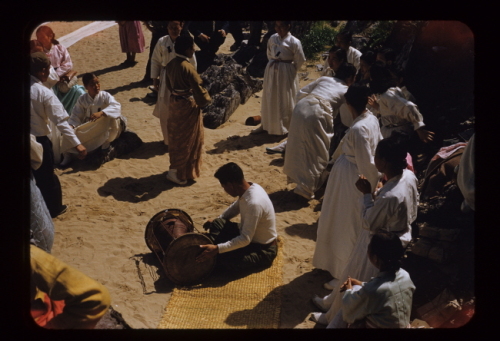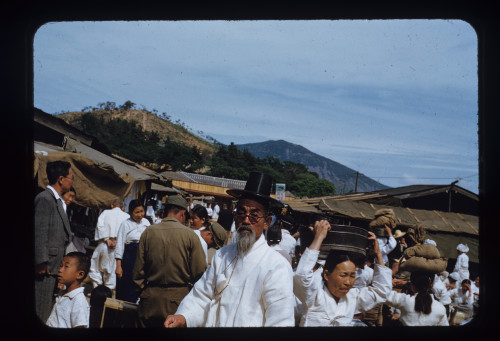Color photographs donated by former U.S. dental officer show unknown side of Korean WarKids are playing with water, men and women sing and dance, and markets are filled with people and energy.
These color photographs, taken by former U.S. dental officer Charles J. Burstone in Busan during the Korean War, are rather hard to believe. Filled with ordinary joys and peaceful moments, these photographs show none of the brutality of war but the everyday lives of the common people in 1952 Busan.
The National Folk Museum of Korea is holding a special photo exhibition, “Korea 1952,” with color photographs and videos that have been donated by Burstone in 2009 and 2010, from June 22 to Sept. 5.
Burstone, who now is an honorary professor of the School of Dental Medicine in the University of Connecticut, served as a dental officer at the K-9 Air Base in Suyeong district in Busan during Korean War in 1952.

People enjoy music and dance near Suyeong district of Busan in 1952 during the Korean War. Taken by Charles J. Burstone. (National Folk Museum of Korea)

People at Dongnae Market in Busan during Korean War in 1952. Taken by Charles J. Burstone. (National Folk Museum of Korea.)
There, Burstone treated the U.S. Air Force Personnel, as well as local Korean patients who would visit his clinic for dental emergencies. Burstone remembers his local patients as “very good, cooperative and appreciative.”
Though he was on call seven days a week, he still had some time to wander off his base and take still photographs and videos. “There were guerillas in the area but it was relatively safe to walk in the countryside even alone,” Burstone wrote in a letter he sent to the National Folk Museum of Korea. “I never carried a rifle or pistol since that would be more dangerous as guerillas from the hills would attack to obtain weapons.”
The color photographs show Burstone’s obvious preference for capturing the ordinary lives of the Korean people, rather than the war itself. He was particularly interested in shooting market scenes and children, who “would always pose for him” and liked being around him.
Curator Kwan Tae-hyo of the National Museum of Korea said the donated photographs are especially valuable because they are shot in color. “It is very rare for any photograph that was taken in Korea in the 1950s to be in color,” he said. “And because Burstone still remembers the details of these photographs ― when and where the photos were taken, the surrounding situations, and others ― provide them for our further research, these photographs are really meaningful historical materials.”
The donation process first began as Park Young-chul, the former Dean of Yonsei University College of Dentistry ― who used to be a student of Burstone ― handed a copy of DVD which contained his teacher’s video footage of Busan to the national museum.
After carefully studying the footage on the DVD, the museum staff in 2009 sent a formal inquiry to Burstone if he could donate the original footage. Burstone happily agreed and sent the original video.
Last year, Burstone offered to donate 79 still photographs that are related to his video footage, and the museum staff visited Burstone his house in Farmington, Connecticut, to accept the photographs in person. The museum staff also interviewed him about his experience in Korea for their research.
“I hope the photographic material that I had taken can be useful in showing a peaceful side of Korea during the war years,” wrote Burstone in his letter to the museum.
Along with the exhibition, the national museum recently published a book called “Korea 1952,” which consists of all the photographs donated by Burstone and other research the museum staff uncovered related to the given photographic material ― including the interview with Burstone last year.
The exhibition is currently being held at the museum. For more information, call (02) 3704-3113.
By Claire Lee (
dyc@heraldcorp.com)




![[Herald Interview] 'Amid aging population, Korea to invite more young professionals from overseas'](http://res.heraldm.com/phpwas/restmb_idxmake.php?idx=645&simg=/content/image/2024/04/24/20240424050844_0.jpg&u=20240424200058)


